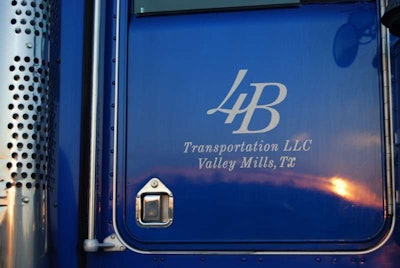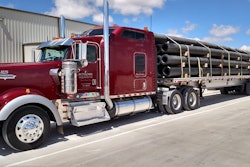
For a small fleet operator who still drives him/herself, finding a self-starter kind of individual with a passion for trucking, or such an individual with clear potential to develop such a passion, is key. Absent employed dispatch and in-house maintenance personnel, and given the time constraint placed on a small fleet operator who still drives, the employed driver to one extent or another will need to be able to take personal control of and effectively manage his time and truck maintenance, and manage his own loads within the small fleet’s universe. Such consideration could be the lynchpin in long-term profitability.
Ted Bowers, owner of two-truck Ted Bowers Trucking of Kingston, Tenn. (Bowers in addition has one owner-operator leased to his business), reported having recently sold two trucks for reasons having to do directly with the trucks’ drivers’ inability to do the things listed above.
 Hear my on-highway talk with independent flatbedder Ted Bowers in his custom-stretched 2005 379 via this link to the Overdrive Radio podcast.
Hear my on-highway talk with independent flatbedder Ted Bowers in his custom-stretched 2005 379 via this link to the Overdrive Radio podcast.One driver knew nothing about the truck’s systems themselves, “and he’d tell you that,” Bowers says, though in many instances the driver was dependable when dispatched.
But in the end his lack of knowledge and generally reactive approach to freight proved more burden than it was worth.
Bowers discussed these issues in details in this podcast:
If the truck/driver situation in small fleet expansion present a chicken-egg type conundrum, Bowers suggests, operators would do well to focus on the driver first.
However, as shown in results from polling below, much of Overdrive’s audience has never been in the position of hiring a driver, and very few respondents (3 percent) reported typically putting their focus on striking an agreement with a dependable driver prior to purchasing a truck. At once, the largest share of respondents (43 percent) reported belief that the driver was the most important part of the expansion equation, whether access to the truck precedes his/her hiring or not.
Small fleets, independents: Ideally, best to buy a truck to fit a dependable driver or hire a driver to fill an empty truck?
An important related consideration also was noted by a significant share (16 percent) of respondents — having the truck first can be a good recruiting tool in some sense, the “best way to seal the deal” with any prospective hire.
However, a driver who exhibits the independent characteristics described above and who could commit to the business before the truck is even available may represent the kind of commitment an owner-operator looking to move to a two-truck operation badly needs to succeed.
As small fleet operations grow, considerations may change. Mark White of Tennessee-based Old Time Express, interviewed last Fall, had freight in excess of his company’s capacity to deliver on actually moving it in its 15 company-owned trucks. At once, he’s turned to a new model of expansion (for Old Time) that in some ways underscores a chicken-egg approach to the driver/truck.
“You’ve got to do something to make yourself stand out from everybody else,” he says. “It will take somebody reinventing the wheel here to alleviate the recruiting and retention problem,” whether with guaranteed detention and other pay models to attract drivers or other things.
 Small fleet operators, what’s your take? If you’re reading on a smartphone, tap the image to call and leave us a message to weigh in. We’ll round up responses in a special mailbag podcast. Alternately, drop a comment below. If you’re on a desktop, call 530-408-6423. Make sure to tell us your name and state of residence.
Small fleet operators, what’s your take? If you’re reading on a smartphone, tap the image to call and leave us a message to weigh in. We’ll round up responses in a special mailbag podcast. Alternately, drop a comment below. If you’re on a desktop, call 530-408-6423. Make sure to tell us your name and state of residence.In a move rather uncommon for such a small fleet, White and his family-owned company moved to negotiations with its insurance company to “start hiring student drivers,” he says. “We went well beyond” what industry-standard guidelines exist for such, as required by the insurance company. Working with a local technical college (within two-three months drivers graduate with a CDL), Old Time then takes the student driver out for a couple weeks to shadow his local driver, and gradually move into solo driving. “It might be up to a two-year program before they’re free and clear” with a dedicated truck, he says. “We even went as far as putting dashcams, forward facing, on the trainees with the trainer – and also once they go solo, for up to two years.”











